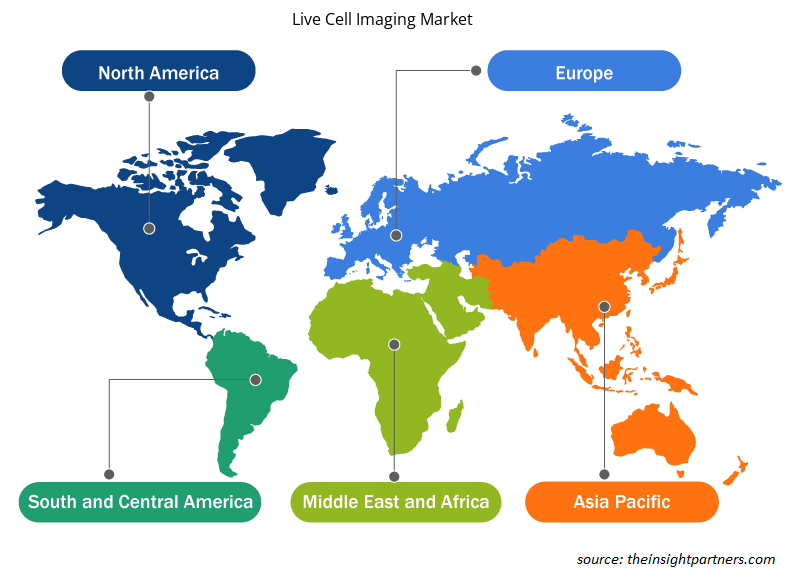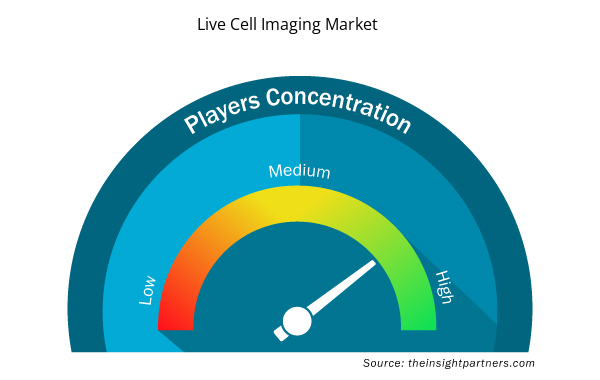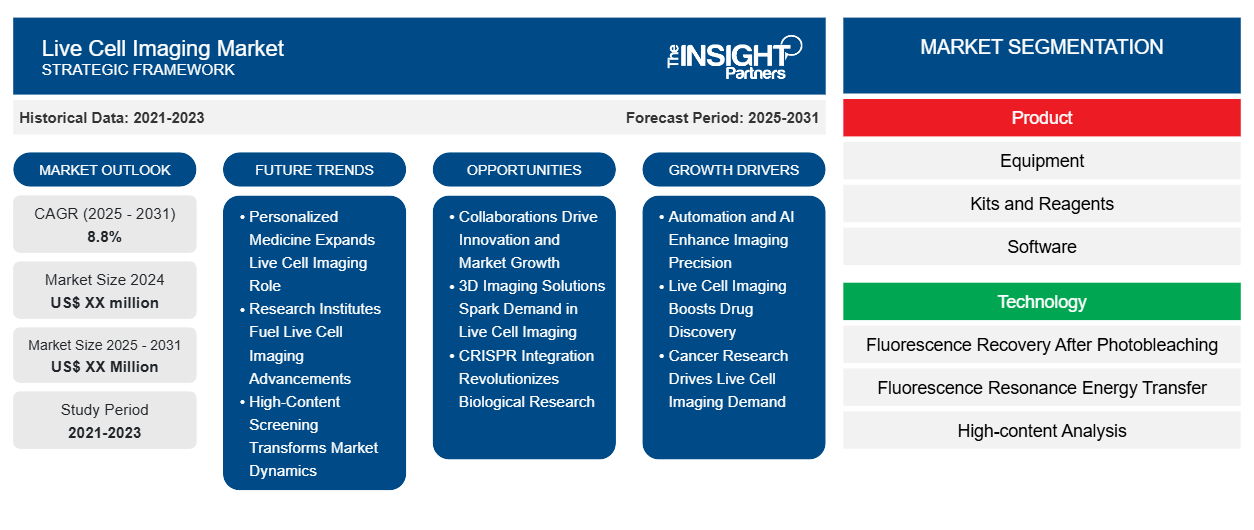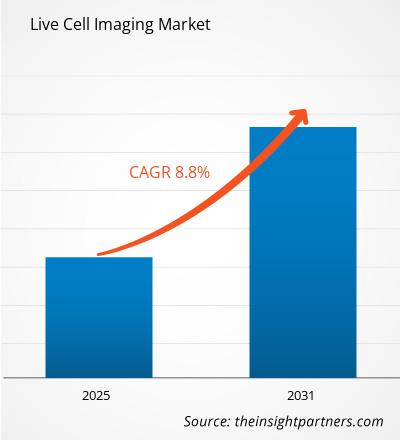Si prevede che il mercato dell'imaging di cellule vive registrerà un CAGR dell'8,8% dal 2023 al 2031, con una dimensione di mercato in espansione da XX milioni di dollari nel 2023 a XX milioni di dollari entro il 2031.
La ricerca di mercato Live Cell Imaging analizza le tendenze chiave e i principali attori del mercato. Il rapporto comprende anche l'analisi per prodotto, tecnologia, applicazione, utente finale e area geografica.
Scopo del rapporto
Il report Live Cell Imaging Market di The Insight Partners mira a descrivere il panorama attuale e la crescita futura, i principali fattori trainanti, le sfide e le opportunità. Ciò fornirà spunti a vari stakeholder aziendali, come:
- Fornitori/produttori di tecnologia: per comprendere le dinamiche di mercato in evoluzione e conoscere le potenziali opportunità di crescita, consentendo loro di prendere decisioni strategiche informate.
- Investitori: condurre un'analisi completa delle tendenze in merito al tasso di crescita del mercato, alle proiezioni finanziarie del mercato e alle opportunità esistenti lungo la catena del valore.
- Enti di regolamentazione: regolamentano le politiche e le attività di controllo sul mercato allo scopo di ridurre al minimo gli abusi, preservare la fiducia degli investitori e sostenere l'integrità e la stabilità del mercato.
Segmentazione del mercato dell'imaging di cellule vive
Prodotto
- Attrezzatura
- Kit e reagenti
- Software
- Materiali di consumo
Tecnologia
- Recupero della fluorescenza dopo il fotosbiancamento
- Trasferimento di energia di risonanza della fluorescenza
- Analisi ad alto contenuto
- Ibridazione fluorescente in situ
- Altri
Applicazione
- Scoperta di farmaci
- Biologia cellulare
- Biologia dello sviluppo
- Cellule staminali
- Altri
Utente finale
- Aziende farmaceutiche e biotecnologiche
- Ospedali
- Laboratori Diagnostici
- Altri
Utente finale
- Aziende farmaceutiche e biotecnologiche
- Ospedali
- Laboratori Diagnostici
- Altri
Personalizza questo report in base alle tue esigenze
Riceverai la personalizzazione gratuita di qualsiasi report, comprese parti di questo report, o analisi a livello nazionale, pacchetto dati Excel, oltre a usufruire di grandi offerte e sconti per start-up e università
- Scopri le principali tendenze di mercato in questo rapporto.Questo campione GRATUITO includerà analisi di dati che spaziano dalle tendenze di mercato alle stime e alle previsioni.
Fattori trainanti della crescita del mercato dell'imaging di cellule vive
- Automazione e intelligenza artificiale migliorano la precisione dell'imaging: i recenti trend migliorati nell'automazione e nell'intelligenza artificiale migliorano ulteriormente la precisione dell'imaging. Ciò verrebbe rianimato dal continuo sviluppo di sistemi di imaging ad alta risoluzione e tecniche sempre più all'avanguardia, come la microscopia a fluorescenza, per un'analisi cellulare più accurata a supporto della scoperta di farmaci e della ricerca sulle malattie. Pertanto, i ricercatori si stanno concentrando su approfondimenti cellulari in tempo reale che alimentano la crescita del mercato globale guidata dalla domanda di tecnologie all'avanguardia che alimentano la loro quota di mercato e trasformano il volto della ricerca scientifica in tutto il mondo.
- L'imaging di cellule vive potenzia la scoperta di farmaci: una maggiore adozione di questa tecnologia nella scoperta e nello sviluppo di farmaci è uno dei principali motori della crescita del mercato dell'imaging di cellule vive. Consente la visualizzazione delle risposte cellulari in tempo reale, che è una delle cose essenziali per effettuare valutazioni dell'efficacia e della tossicità dei farmaci. Le analisi di mercato indicano che le aziende farmaceutiche hanno investito in modo significativo nell'imaging di cellule vive per accelerare le pipeline e migliorare i risultati nel trattamento. Poiché la medicina personalizzata ha preso piede, le dimensioni del mercato sono piuttosto espansive e consentono all'imaging di cellule vive di svolgere un ruolo utile nel plasmare il futuro degli sviluppi e dell'innovazione dell'assistenza sanitaria globale.
- La ricerca sul cancro stimola la domanda di imaging di cellule vive: l'imaging di cellule vive sta acquisendo importanza negli studi sul cancro per comprendere la crescita tumorale, le metastasi e il comportamento cellulare. La domanda di questa tecnica aumenterà quindi dal monitoraggio delle interazioni tra cellule tumorali e microambiente. La crescente adozione dell'oncologia di precisione sta incoraggiando le dimensioni del mercato secondo i report di mercato. I ricercatori stanno prendendo di mira queste tecniche per realizzare terapie contro il cancro più mirate che cambiano notevolmente le tendenze di mercato e determinano quote di mercato più elevate tra istituti di ricerca e operatori sanitari in tutto il mondo.
Tendenze future del mercato dell'imaging delle cellule vive
- La medicina personalizzata amplia il ruolo dell'imaging delle cellule vive: l'imaging delle cellule vive è diventato parte della medicina personalizzata grazie alla sua crescente applicazione nella diagnostica e nelle terapie. Le tecniche di imaging avanzate offrono trattamenti personalizzati attraverso approfondimenti più approfonditi sui comportamenti cellulari di diversi pazienti. Le attuali tendenze di mercato sono dominate dagli adattamenti attraverso cambiamenti nelle strategie degli attori chiave che coinvolgono terapie mirate. L'analisi SWOT sottolinea l'opportunità di crescita in questo particolare settore nonostante gli elevati costi di investimento rimangano una sfida. L'analisi PEST insiste inoltre sul fatto che i cambiamenti demografici benigni continueranno a sostenere la domanda.
- Gli istituti di ricerca alimentano i progressi dell'imaging di cellule vive: IL QUADRO PESTEL/STRATEGICO: Gli istituti di apprendimento e ricerca stanno diventando sempre più abili nel realizzare tecnologie di imaging di cellule vive come input per promuovere la ricerca in biologia e medicina. Ciò è dovuto alla collaborazione con leader del settore e piattaforme di imaging all'avanguardia. L'analisi SWOT afferma che l'innovazione accademica è un punto di forza, mentre la mancanza di un budget adeguato è considerata una debolezza. Secondo l'analisi PEST, i fattori di crescita sono ben finanziati dal governo e hanno un forte supporto politico. Di conseguenza, l'investimento nella ricerca da parte di tali istituzioni ha implicato che i principali attori inizino a riadattare le loro strategie di mercato per soddisfare tali esigenze educative.
- Lo screening ad alto contenuto trasforma le dinamiche di mercato: lo screening ad alto contenuto viene sempre più adottato nel mercato dell'imaging di cellule vive per il suo potenziale di analizzare grandi set di dati da esperimenti su cellule vive. Ha anche trasformato le dinamiche di mercato in cui i principali attori stanno adottando strategie di mercato basate su HCS per creare una ricerca efficiente. I punti di forza sono evidenziati attraverso l'analisi SWOT tramite l'acquisizione di dati ad alto rendimento nonostante le sfide nell'interpretazione dei dati. I crescenti finanziamenti governativi e istituzionali e la domanda per questa applicazione nei settori accademico e farmaceutico stanno quindi alimentando l'adozione del mercato, secondo l'analisi PEST.
Opportunità di mercato per l'imaging di cellule vive
- Le collaborazioni stimolano l'innovazione e la crescita del mercato: la collaborazione tra istituti di ricerca e aziende in diverse aree geografiche sta emergendo come un fattore determinante nel mercato dell'imaging di cellule vive. L'analisi competitiva ha indicato che il 38% dei centri di ricerca nordamericani ed europei sta ora collaborando a progetti che utilizzano l'imaging di cellule vive che propagano innovazione e crescita. Questa tendenza offre ai leader di mercato l'opportunità di espandere la propria presenza e personalizzare le soluzioni per soddisfare le esigenze di ricerca collaborativa. Di natura globale, queste partnership stanno rimodellando il volto del settore, in particolare in regioni in crescita come l'Asia-Pacifico.
- Le soluzioni di imaging 3D stimolano la domanda nell'imaging di cellule vive: le soluzioni di imaging 3D avanzate e ad alta risoluzione, in particolare per quanto riguarda strutture cellulari e tessuti complessi, sono molto richieste nel mercato dell'imaging di cellule vive. Ciò apre una grande opportunità per le aziende che sviluppano prodotti di imaging specifici per il 3D. Le prospettive della tecnologia stanno guadagnando attenzione anche in Europa, dove l'attenzione alla ricerca di precisione sta rivoluzionando lo scenario generale del settore.
- L'integrazione CRISPR rivoluziona la ricerca biologica: l'integrazione dell'imaging di cellule vive con l'editing genetico CRISPR sta rivoluzionando la ricerca biologica, un'importante opportunità di crescita. Ciò porta a un panorama competitivo positivo per le aziende che investono nell'integrazione con le aree geografiche chiave di Europa e Asia-Pacifico.
Approfondimenti regionali sul mercato dell'imaging di cellule vive
Le tendenze regionali e i fattori che influenzano il mercato Live Cell Imaging durante il periodo di previsione sono stati ampiamente spiegati dagli analisti di Insight Partners. Questa sezione discute anche i segmenti e la geografia del mercato Live Cell Imaging in Nord America, Europa, Asia Pacifico, Medio Oriente e Africa e Sud e Centro America.

- Ottieni i dati specifici regionali per il mercato dell'imaging delle cellule vive
Ambito del rapporto di mercato sull'imaging delle cellule vive
| Attributo del report | Dettagli |
|---|---|
| Dimensioni del mercato nel 2023 | XX milioni di dollari USA |
| Dimensioni del mercato entro il 2031 | XX milioni di dollari USA |
| CAGR globale (2023-2031) | 8,8% |
| Dati storici | 2021-2022 |
| Periodo di previsione | 2024-2031 |
| Segmenti coperti | Per Prodotto
|
| Regioni e Paesi coperti | America del Nord
|
| Leader di mercato e profili aziendali chiave |
|
Densità degli attori del mercato dell'imaging cellulare in tempo reale: comprendere il suo impatto sulle dinamiche aziendali
Il mercato Live Cell Imaging Market sta crescendo rapidamente, spinto dalla crescente domanda degli utenti finali dovuta a fattori quali l'evoluzione delle preferenze dei consumatori, i progressi tecnologici e una maggiore consapevolezza dei benefici del prodotto. Con l'aumento della domanda, le aziende stanno ampliando le loro offerte, innovando per soddisfare le esigenze dei consumatori e capitalizzando sulle tendenze emergenti, il che alimenta ulteriormente la crescita del mercato.
La densità degli operatori di mercato si riferisce alla distribuzione di aziende o società che operano in un particolare mercato o settore. Indica quanti concorrenti (operatori di mercato) sono presenti in un dato spazio di mercato in relazione alle sue dimensioni o al valore di mercato totale.
Le principali aziende che operano nel mercato dell'imaging di cellule vive sono:
- Thermo Fisher Scientific Inc.
- PerkinElmer Inc.
- Elettrico generale
- Società Olimpo
- Strumenti BioTek, Inc.
Disclaimer : le aziende elencate sopra non sono classificate secondo un ordine particolare.

- Ottieni una panoramica dei principali attori del mercato dell'imaging delle cellule vive
Punti di forza chiave
- Copertura completa: il rapporto copre in modo completo l'analisi di prodotti, servizi, tipologie e utenti finali del mercato dell'imaging di cellule vive, fornendo una panoramica olistica.
- Analisi degli esperti: il rapporto è compilato sulla base della conoscenza approfondita di esperti e analisti del settore.
- Informazioni aggiornate: il rapporto garantisce la pertinenza aziendale grazie alla copertura di informazioni recenti e tendenze nei dati.
- Opzioni di personalizzazione: questo report può essere personalizzato per soddisfare le esigenze specifiche del cliente e adattarsi in modo appropriato alle strategie aziendali.
Il rapporto di ricerca sul mercato Live Cell Imaging può, quindi, aiutare a guidare il percorso di decodifica e comprensione dello scenario del settore e delle prospettive di crescita. Sebbene possano esserci alcune preoccupazioni valide, i vantaggi complessivi di questo rapporto tendono a superare gli svantaggi.
- Analisi storica (2 anni), anno base, previsione (7 anni) con CAGR
- Analisi PEST e SWOT
- Valore/volume delle dimensioni del mercato - Globale, regionale, nazionale
- Industria e panorama competitivo
- Set di dati Excel


- Airline Ancillary Services Market
- Power Bank Market
- Online Exam Proctoring Market
- Rare Neurological Disease Treatment Market
- Integrated Platform Management System Market
- Single-Use Negative Pressure Wound Therapy Devices Market
- Photo Printing Market
- Virtual Pipeline Systems Market
- Playout Solutions Market
- Dealer Management System Market

Report Coverage
Revenue forecast, Company Analysis, Industry landscape, Growth factors, and Trends

Segment Covered
This text is related
to segments covered.

Regional Scope
North America, Europe, Asia Pacific, Middle East & Africa, South & Central America

Country Scope
This text is related
to country scope.
Domande frequenti
The report can be delivered in PDF/PPT format; we can also share excel dataset based on the request.
Some of the customization options available based on request are additional 3-5 company profiles and country-specific analysis of 3-5 countries of your choice. Customizations are to be requested/discussed before making final order confirmation, as our team would review the same and check the feasibility.
Key companies in this market are: Thermo Fisher Scientific Inc, PerkinElmer Inc, General Electric, Olympus Corporation, BioTek Instruments Inc, Molecular Devices LLC, CYTOSKELETON INC, Bruker, Nikon Instruments Inc
The Live Cell Imaging Market is expected to register a CAGR of 8.8% from 2023-2031.
Key future trends in this market are - Advancements in microscopy technologies, Growth in drug discovery, Demand for real-time cell analysis
The major factors impacting the Live Cell Imaging Market are: Technological Advancements in Imaging Systems, Rising Demand in Drug Discovery and Development, and Growing Application in Cancer Research
Trends and growth analysis reports related to Life Sciences : READ MORE..
The List of Companies
1. Thermo Fisher Scientific Inc.
2. PerkinElmer Inc.
3. General Electric
4. Olympus Corporation
5. BioTek Instruments, Inc.
6. Molecular Devices, LLC.
7. CYTOSKELETON, INC.
8. Bruker
9. Nikon Instruments Inc.
10. Merck KGaA
11. Keyence Corporation
12. NanoLive SA
13. Sony Biotechnology Inc.
14. Phase Focus
15. Logos Biosystems (Aligned Genetics, Inc.)
The Insight Partners performs research in 4 major stages: Data Collection & Secondary Research, Primary Research, Data Analysis and Data Triangulation & Final Review.
- Data Collection and Secondary Research:
As a market research and consulting firm operating from a decade, we have published and advised several client across the globe. First step for any study will start with an assessment of currently available data and insights from existing reports. Further, historical and current market information is collected from Investor Presentations, Annual Reports, SEC Filings, etc., and other information related to company’s performance and market positioning are gathered from Paid Databases (Factiva, Hoovers, and Reuters) and various other publications available in public domain.
Several associations trade associates, technical forums, institutes, societies and organization are accessed to gain technical as well as market related insights through their publications such as research papers, blogs and press releases related to the studies are referred to get cues about the market. Further, white papers, journals, magazines, and other news articles published in last 3 years are scrutinized and analyzed to understand the current market trends.
- Primary Research:
The primarily interview analysis comprise of data obtained from industry participants interview and answers to survey questions gathered by in-house primary team.
For primary research, interviews are conducted with industry experts/CEOs/Marketing Managers/VPs/Subject Matter Experts from both demand and supply side to get a 360-degree view of the market. The primary team conducts several interviews based on the complexity of the markets to understand the various market trends and dynamics which makes research more credible and precise.
A typical research interview fulfils the following functions:
- Provides first-hand information on the market size, market trends, growth trends, competitive landscape, and outlook
- Validates and strengthens in-house secondary research findings
- Develops the analysis team’s expertise and market understanding
Primary research involves email interactions and telephone interviews for each market, category, segment, and sub-segment across geographies. The participants who typically take part in such a process include, but are not limited to:
- Industry participants: VPs, business development managers, market intelligence managers and national sales managers
- Outside experts: Valuation experts, research analysts and key opinion leaders specializing in the electronics and semiconductor industry.
Below is the breakup of our primary respondents by company, designation, and region:

Once we receive the confirmation from primary research sources or primary respondents, we finalize the base year market estimation and forecast the data as per the macroeconomic and microeconomic factors assessed during data collection.
- Data Analysis:
Once data is validated through both secondary as well as primary respondents, we finalize the market estimations by hypothesis formulation and factor analysis at regional and country level.
- Macro-Economic Factor Analysis:
We analyse macroeconomic indicators such the gross domestic product (GDP), increase in the demand for goods and services across industries, technological advancement, regional economic growth, governmental policies, the influence of COVID-19, PEST analysis, and other aspects. This analysis aids in setting benchmarks for various nations/regions and approximating market splits. Additionally, the general trend of the aforementioned components aid in determining the market's development possibilities.
- Country Level Data:
Various factors that are especially aligned to the country are taken into account to determine the market size for a certain area and country, including the presence of vendors, such as headquarters and offices, the country's GDP, demand patterns, and industry growth. To comprehend the market dynamics for the nation, a number of growth variables, inhibitors, application areas, and current market trends are researched. The aforementioned elements aid in determining the country's overall market's growth potential.
- Company Profile:
The “Table of Contents” is formulated by listing and analyzing more than 25 - 30 companies operating in the market ecosystem across geographies. However, we profile only 10 companies as a standard practice in our syndicate reports. These 10 companies comprise leading, emerging, and regional players. Nonetheless, our analysis is not restricted to the 10 listed companies, we also analyze other companies present in the market to develop a holistic view and understand the prevailing trends. The “Company Profiles” section in the report covers key facts, business description, products & services, financial information, SWOT analysis, and key developments. The financial information presented is extracted from the annual reports and official documents of the publicly listed companies. Upon collecting the information for the sections of respective companies, we verify them via various primary sources and then compile the data in respective company profiles. The company level information helps us in deriving the base number as well as in forecasting the market size.
- Developing Base Number:
Aggregation of sales statistics (2020-2022) and macro-economic factor, and other secondary and primary research insights are utilized to arrive at base number and related market shares for 2022. The data gaps are identified in this step and relevant market data is analyzed, collected from paid primary interviews or databases. On finalizing the base year market size, forecasts are developed on the basis of macro-economic, industry and market growth factors and company level analysis.
- Data Triangulation and Final Review:
The market findings and base year market size calculations are validated from supply as well as demand side. Demand side validations are based on macro-economic factor analysis and benchmarks for respective regions and countries. In case of supply side validations, revenues of major companies are estimated (in case not available) based on industry benchmark, approximate number of employees, product portfolio, and primary interviews revenues are gathered. Further revenue from target product/service segment is assessed to avoid overshooting of market statistics. In case of heavy deviations between supply and demand side values, all thes steps are repeated to achieve synchronization.
We follow an iterative model, wherein we share our research findings with Subject Matter Experts (SME’s) and Key Opinion Leaders (KOLs) until consensus view of the market is not formulated – this model negates any drastic deviation in the opinions of experts. Only validated and universally acceptable research findings are quoted in our reports.
We have important check points that we use to validate our research findings – which we call – data triangulation, where we validate the information, we generate from secondary sources with primary interviews and then we re-validate with our internal data bases and Subject matter experts. This comprehensive model enables us to deliver high quality, reliable data in shortest possible time.


 Ottieni un campione gratuito per questo repot
Ottieni un campione gratuito per questo repot